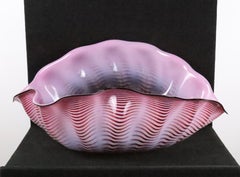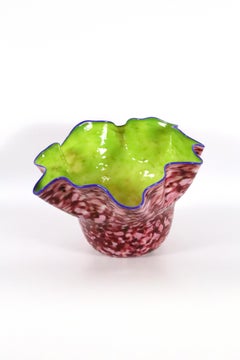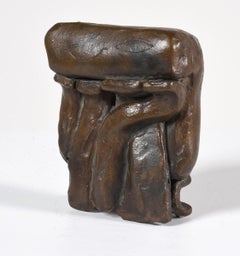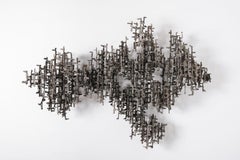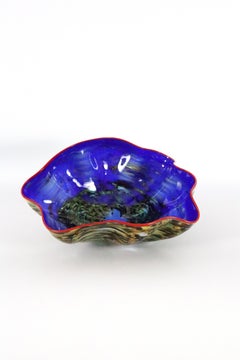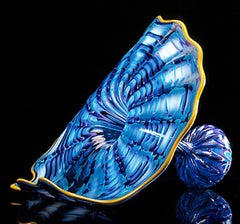Dale Chihuly More Art
With his sculptural works that fuse naturalistic forms with vibrant colors, Dale Chihuly has established himself as one of the world’s preeminent contemporary makers of art glass. The Tacoma, Washington, native’s experimental techniques — manifest in large-scale glass sculptures, installations and environmental artworks alongside smaller table-top pieces — combine fine art, design, architecture and craft.
Chihuly’s inspired creative energy has brought glass blowing to a place at the forefront of the arts in the United States. His prolific body of work is coupled with a dedication to artistic instruction, education and community. Trained in interior design at the University of Washington, he pursued graduate work with Harvey Littleton, who built the first academic art glass program in the U.S. at the University of Wisconsin-Madison. After further studies at the Rhode Island School of Design, Chihuly was awarded a 1968 Fulbright Fellowship to study glass blowing at the Venini glass factory on the island of Murano in Venice, where he was first introduced to group collaboration in glass making. Not only has Chihuly been committed to his own improvement as an artist, but he has also devoted much of his career to sharing his knowledge. He returned to RISD as an instructor, and after working there for more than a decade and he cofounded the Pilchuck Glass School in Washington State in 1971. An automobile accident in 1976 left Chihuly blind in one eye; a subsequent injury while bodysurfing weakened one shoulder, leaving him reliant on assistant glassblowers to execute his designs.
Chihuly’s skills and technical innovations have allowed him to make pieces in an astonishing array of patterns, textures and hues — yet his work can be recognized immediately. He has created several notable extended series of artworks. These include his “Seaforms,” which evoke shells, starfish and other marine animals; “Blankets,” which are composed of cylindrical units in patterns suggested by Native American textiles; and, most famously, his grand chandeliers made up of scores of curling, curving, pepper-shaped elements. Whether large or small, as you will see on 1stDibs, the works of Dale Chihuly blend practical flair and bravura artistry. They are a highlight of any contemporary art and design collection.
1990s American Modern Dale Chihuly More Art
Glass, Blown Glass
1990s American Modern Dale Chihuly More Art
Glass, Blown Glass
Late 20th Century American Modern Dale Chihuly More Art
Bronze
Mid-20th Century American Modern Dale Chihuly More Art
Steel
20th Century American Modern Dale Chihuly More Art
Granite, Bronze
1940s American Modern Dale Chihuly More Art
Cast Stone
Late 20th Century American Modern Dale Chihuly More Art
Bronze
20th Century American Modern Dale Chihuly More Art
Bronze
1940s American Modern Dale Chihuly More Art
Cast Stone
1990s American Modern Dale Chihuly More Art
Metal
20th Century American Modern Dale Chihuly More Art
Metal
Mid-20th Century American Modern Dale Chihuly More Art
Ceramic
1930s American Modern Dale Chihuly More Art
Plaster
1970s American Modern Dale Chihuly More Art
Metal
1990s American Modern Dale Chihuly More Art
Glass, Blown Glass
Early 2000s American Modern Dale Chihuly More Art
Blown Glass
Dale Chihuly more art for sale on 1stDibs.
Artists Similar to Dale Chihuly
- 1stDibs ExpertFebruary 1, 2024The nationality of Dale Chihuly is American. He was born in Tacoma, Washington, on September 20, 1941. In terms of his ancestry, the glassmaker is of Hungarian, Czech, Slavic, Swedish and Norwegian descent. Over the course of his career, Chihuly established himself as one of the world's preeminent contemporary makers of art glass and became well known for his experimental techniques. Explore a selection of Dale Chihuly art on 1stDibs.
- What is Dale Chihuly famous for?1 Answer1stDibs ExpertMay 3, 2024Dale Chihuly is famous for his work as an artist. With his sculptural pieces that fuse naturalistic forms with vibrant colors, he has established himself as one of the world's preeminent contemporary makers of art glass. The Tacoma, Washington, native's experimental techniques are used to produce large-scale glass sculptures, installations, environmental and smaller table-top pieces, all combining aspects of fine art, design and architecture. Find a collection of Dale Chihuly art on 1stDibs.
- What happened to Dale Chihuly?1 Answer1stDibs ExpertFebruary 21, 2024What happened to Dale Chihuly is the story of an artist who continues to fascinate art lovers and inspire viewers with his glass sculptures, installations and environmental artworks. Alongside his artistic practice, Chihuly has worked as an educator, cofounding the Pilchuck Glass School in Stanwood, Washington, and heading up the glass program at the Rhode Island School of Design. He also advocates for making fine art accessible to everyone through youth outreach programs like Hilltop Artists and large-scale public projects like Chihuly Over Venice and Chihuly in the Light of Jerusalem. Explore a selection of Dale Chihuly art on 1stDibs.
- Does Dale Chihuly blow glass?1 Answer1stDibs ExpertApril 5, 2022No, Dale Chihuly no longer blows glass. Dale Chihuly did blow glass until he dislocated his right shoulder in 1979. The injury prevented him from properly holding the glass blowing pipe. However, he did hire others to do the work under his supervision. Shop a wide selection of Dale Chihuly glass pieces on 1stDibs.
- 1stDibs ExpertApril 5, 2022Dale Chihuly is best known for creating sculptures out of glass. His installation projects helped launch him into the art world's spotlight and include Ethereal White Persian Pond, Desert Towers and Opal and Amber Towers. You'll find a variety of Dale Chihuly art on 1stDibs.
- 1stDibs ExpertApril 5, 2022Artist Dale Chihuly is best known for his glass sculptures. Chihuly studied interior design and received a Masters of Science in sculpture from the University of Wisconsin where he studied glassblowing. His works with glass are often featured in large installations and exhibitions earning raves around the globe. Shop a selection of Dale Chihuly pieces from some of the world’s top art dealers on 1stDibs.
- 1stDibs ExpertApril 5, 2022Yes, Dale Chihuly still makes art. At this stage in his career he is very accomplished and well-known for his glass works. He has also experimented in paint, plastic, neon and other materials and is constantly pushing the art envelope to create new works and installations. On 1stDibs, find a variety of original artwork from top artists.
